The AMD Radeon R9 290X Review
by Ryan Smith on October 24, 2013 12:01 AM EST- Posted in
- GPUs
- AMD
- Radeon
- Hawaii
- Radeon 200
Compute
Jumping into pure compute performance, we’re going to have several new factors influencing the 290X as compared to the 280X. On the front end 290X/Hawaii has those 8 ACEs versus 280X/Tahiti’s 2 ACEs, potentially allowing 290X to queue up a lot more work and to keep itself better fed as a result; though in practice we don’t expect most workloads to be able to put the additional ACEs to good use at the moment. Meanwhile on the back end 290X has that 11% memory bandwidth boost and the 33% increase in L2 cache, which in compute workloads can be largely dedicated to said computational work. On the other hand 290X takes a hit to its double precision floating point (FP64) rate versus 280X, so in double precision scenarios it’s certainly going to enter with a larger handicap.
As always we'll start with our DirectCompute game example, Civilization V, which uses DirectCompute to decompress textures on the fly. Civ V includes a sub-benchmark that exclusively tests the speed of their texture decompression algorithm by repeatedly decompressing the textures required for one of the game’s leader scenes. While DirectCompute is used in many games, this is one of the only games with a benchmark that can isolate the use of DirectCompute and its resulting performance.
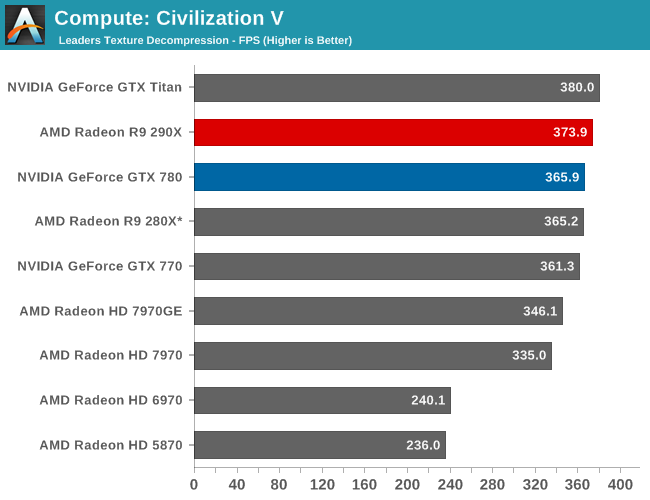
Unfortunately Civ V can’t tell us much of value, due to the fact that we’re running into CPU bottlenecks, not to mention increasingly absurd frame rates. In the 3 years since this game was released high-end CPUs are around 20% faster per core, whereas GPUs are easily 150% faster (if not more). As such the GPU portion of texture decoding has apparently started outpacing the CPU portion, though this is still an enlightening benchmark for anything less than a high-end video card.
For what it is worth, the 290X can edge out the GTX 780 here, only to fall to GTX Titan. But in these CPU limited scenarios the behavior at the very top can be increasingly inconsistent.
Our next benchmark is LuxMark2.0, the official benchmark of SmallLuxGPU 2.0. SmallLuxGPU is an OpenCL accelerated ray tracer that is part of the larger LuxRender suite. Ray tracing has become a stronghold for GPUs in recent years as ray tracing maps well to GPU pipelines, allowing artists to render scenes much more quickly than with CPUs alone.
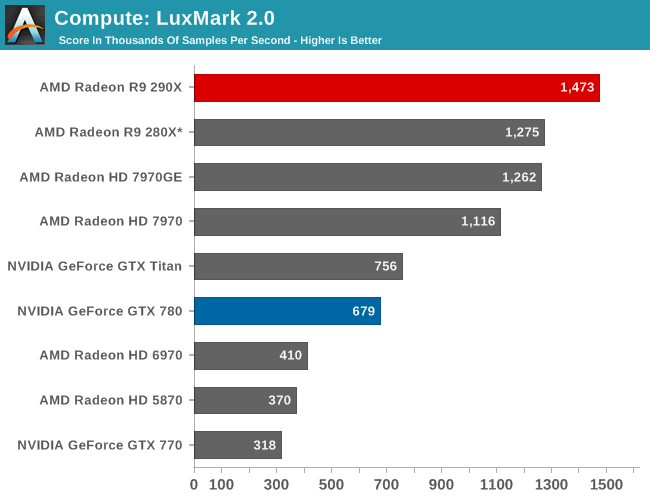
LuxMark by comparison is very simple and very scalable. 290X packs with it a significant increase in computational resources, so 290X picks up from where 280X left off and tops the chart for AMD once more. Titan is barely half as fast here, and GTX 780 falls back even further. Though the fact that scaling from the 280X to 290X is only 16% – a bit less than half of the increase in CUs – is surprising at first glance. Even with the relatively simplistic nature of the benchmark, it has shown signs in the past of craving memory bandwidth and certainly this seems to be one of those times. Feeding those CUs with new rays takes everything the 320GB/sec memory bus of the 290X can deliver, putting a cap on performance gains versus the 280X.
Our 3rd compute benchmark is Sony Vegas Pro 12, an OpenGL and OpenCL video editing and authoring package. Vegas can use GPUs in a few different ways, the primary uses being to accelerate the video effects and compositing process itself, and in the video encoding step. With video encoding being increasingly offloaded to dedicated DSPs these days we’re focusing on the editing and compositing process, rendering to a low CPU overhead format (XDCAM EX). This specific test comes from Sony, and measures how long it takes to render a video.
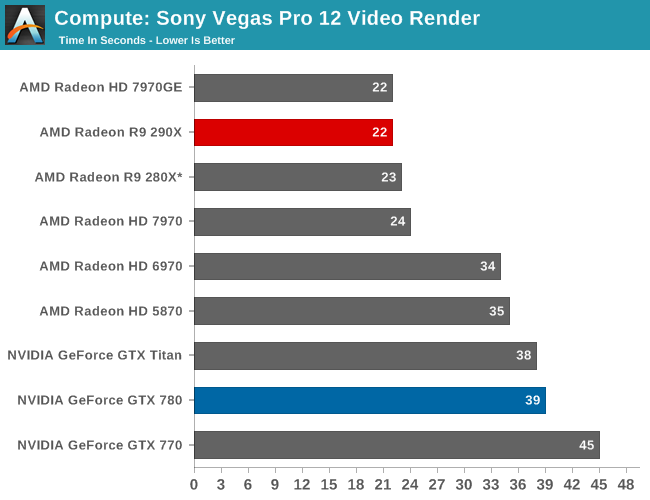
Vegas is another title where GPU performance gains are outpacing CPU performance gains, and as such earlier GPU offloading work has reached its limits and led to the program once again being CPU limited. It’s a shame GPUs have historically underdelivered on video encoding (as opposed to video rendering), as wringing significantly more out of Vegas will require getting rid of the next great CPU bottleneck.
Our 4th benchmark set comes from CLBenchmark 1.1. CLBenchmark contains a number of subtests; we’re focusing on the most practical of them, the computer vision test and the fluid simulation test. The former being a useful proxy for computer imaging tasks where systems are required to parse images and identify features (e.g. humans), while fluid simulations are common in professional graphics work and games alike.
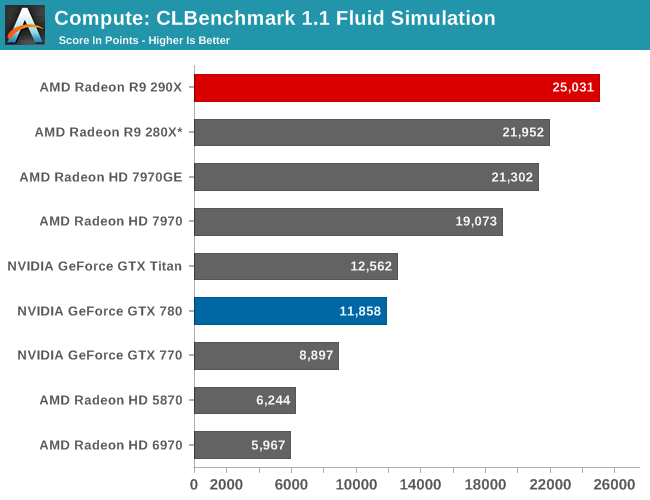
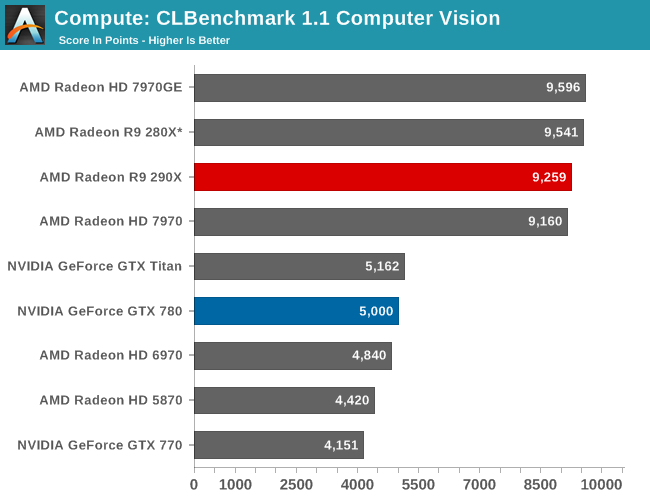
Curiously, the 290X’s performance advantage over 280X is unusual dependent on the specific sub-test. The fluid simulation scales decently enough with the additional CUs, but the computer vision benchmark is stuck in the mud as compared to the 280X. The fluid simulation is certainly closer than the vision benchmark towards being the type of stupidly parallel workload GPUs excel at, though that doesn’t fully explain the lack of scaling in computer vision. If nothing else it’s a good reminder of why professional compute workloads are typically profiled and optimized against specific target hardware, as it reduces these kinds of outcomes in complex, interconnected workloads.
Moving on, our 5th compute benchmark is FAHBench, the official Folding @ Home benchmark. Folding @ Home is the popular Stanford-backed research and distributed computing initiative that has work distributed to millions of volunteer computers over the internet, each of which is responsible for a tiny slice of a protein folding simulation. FAHBench can test both single precision and double precision floating point performance, with single precision being the most useful metric for most consumer cards due to their low double precision performance. Each precision has two modes, explicit and implicit, the difference being whether water atoms are included in the simulation, which adds quite a bit of work and overhead. This is another OpenCL test, as Folding @ Home has moved exclusively to OpenCL this year with FAHCore 17.
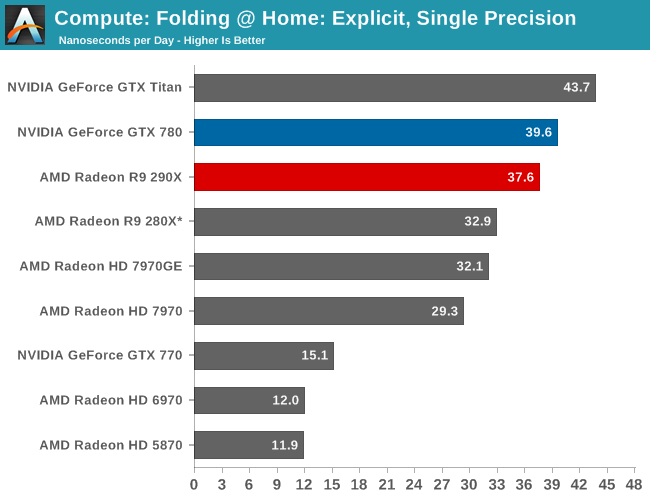
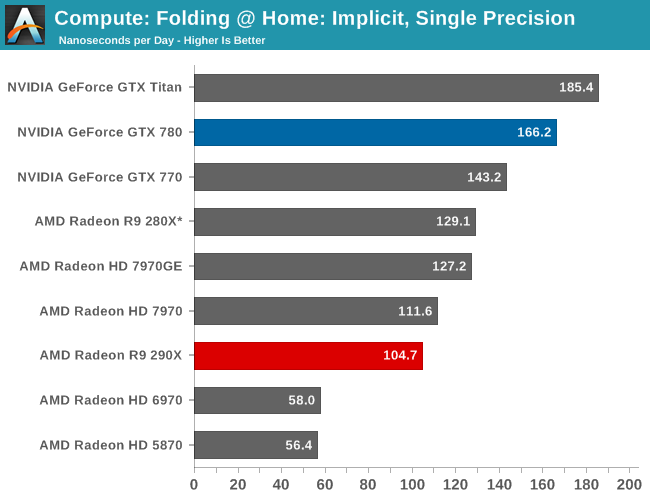

With FAHBench we’re not fully convinced that it knows how to best handle 290X/Hawaii as opposed to 280X/Tahiti. The scaling in single precision explicit is fairly good, but the performance regression in the water-free (and generally more GPU-limited) implicit simulation is unexpected. Consequently while the results are accurate for FAHCore 17, it’s hopefully something AMD and/or the FAH project can work out now that 290X has been released.
Meanwhile double precision performance also regresses, though here we have a good idea why. With DP performance on 290X being 1/8 FP32 as opposed to ¼ on 280X, this is a benchmark 290X can’t win. Though given the theoretical performance differences we should be expecting between the two video cards – 290X should have about 70% of the FP 64 performance of 280X – the fact that 290X is at 82% bodes well for AMD’s newest GPU. However there’s no getting around the fact that the 290X loses to GTX 780 here even though the GTX 780 is even more harshly capped, which given AMD’s traditional strength in OpenCL compute performance is going to be a let-down.
Wrapping things up, our final compute benchmark is an in-house project developed by our very own Dr. Ian Cutress. SystemCompute is our first C++ AMP benchmark, utilizing Microsoft’s simple C++ extensions to allow the easy use of GPU computing in C++ programs. SystemCompute in turn is a collection of benchmarks for several different fundamental compute algorithms, as described in this previous article, with the final score represented in points. DirectCompute is the compute backend for C++ AMP on Windows, so this forms our other DirectCompute test.
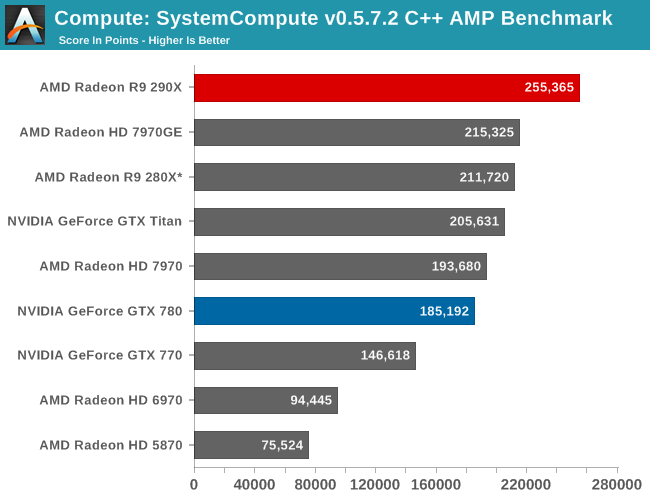
SystemCompute and the underlying C++ AMP environment scales relatively well with the additional CUs offered by 290X. Not only does the 290X easily surpass the GTX Titan and GTX 780 here, but it does so while also beating the 280X by 18%. Or to use AMD’s older GPUs as a point of comparison, we’re up to a 3.4x improvement over 5870, well above the improvement in CU density alone and another reminder of how AMD has really turned things around on the GPU compute side with GCN.










396 Comments
View All Comments
Da W - Thursday, October 24, 2013 - link
The reference cooler is noisy as hell, but it's a blower. At least it doesn't dump all the heat inside your case and let your other case fans handle it. It depends what you're looking for.Still make as much noise as the 5870 did, and it was a commercial success.
slickr - Thursday, October 24, 2013 - link
Didn't think AMD will deliver, in fact I thought from seeing some initial benchmarks that AMD took over 6 months just to deliver a graphic card slower than Titan and that even with a cheap price it wouldn't be enough, boy was I wrong.This card beats Titan in so many games and in so many resolutions and is almost $500 cheaper, its also $100 cheaper than the GTX 780 and anywhere from 5% to 20% faster than the 780, that is just amazing.
Hopefully this trickles down to the medium range cards and we are going to see cards like the 280x go for less than $250.
I mean unless Nvidia positiones the Titan at $550 as well, then I don't think it will sell very much at all. In the 290x you have a better performing card at almost half the price, Nvidia has its work cut out for them and I sure hope the 780 TI edition really brings in the performance and price as well.
eanazag - Thursday, October 24, 2013 - link
I'm sporting a Nvidia GPU in my rig. I don't see any option for Nvidia than to reduce both the Titan, 770, and 780 in cost. I can't expect the 780 Ti performance to trump the Titan. I will say that there is power and cooling room for Nvidia to ratchet things up and make this interesting. This is bold move on AMDs part and does wonders for consumers. Based on some of the other comments current news does not kill off either brand by the way. PC gaming and desktops are not dead.....kwrzesien - Thursday, October 24, 2013 - link
Ryan, can we get a pipeline article or retweet this article when it is complete? Thanks!spiked_mistborn - Thursday, October 24, 2013 - link
Nice job AMD! Competition is good! Also, feel free to use my GSYNC idea about putting a frame buffer in the display and letting the video card control the refresh rate. This post is from March 2013. Apparently adding a dash to make it G-Sync makes it different somehow. http://techreport.com/discussion/24553/inside-the-...Sorodsam - Thursday, October 24, 2013 - link
I'm surprised no one's commented on the new "AMD Center", or this troubling text:"You've landed on the AMD Portal on AnandTech. This section is sponsored by AMD."
There's a big difference between a site that runs an occasional AMD ad and a site with an entire section that's expressively "sponsored by AMD", especially considering AnandTech's (former?) guiding principle that product reviewers shouldn't be aware of who exactly is buying advertising and when. They can hardly be unaware of it now.
MrMaestro - Thursday, October 24, 2013 - link
The reason people aren't commenting on it is because it's already been commented on. Take a look at the article announcing AMD Centre. That is the appropriate place for such comments.anevmann - Thursday, October 24, 2013 - link
Ryan, will this card require PCIe 3.0 for gaming?Can you do a test with and without PCIe 3.0? I really want this card, but I wanna know in advance if I have to upgrade my system.
A
Ryan Smith - Monday, October 28, 2013 - link
I can't promise when it will be done (given the insanity of our schedule over the next 3 weeks), but at some point we will follow this up with a reprise article, that among other things will cover PCIe bandwidth vs. Crossfire scaling, CF testing in quiet mode, and some noise equalization to see what fan levels it would take to match a GTX 780 and what the resulting performance would look like.Anyhow, for a single card setup none of my data thus far supports PCIe 3.0 being a requirement. We're not to the point yet where PCIe 2.0 x16 is a general gaming bottleneck.
Hung_Low - Thursday, October 24, 2013 - link
Is 290X really the absolute maxed out version Tahiti? Or did it also leave a lot of room like Titan is for GK110.Perhaps the GPUs used in 290x are those Tahiti's with imperfection, with the high quality Tahiti's saved for extreme edition 290x/290x+ ?